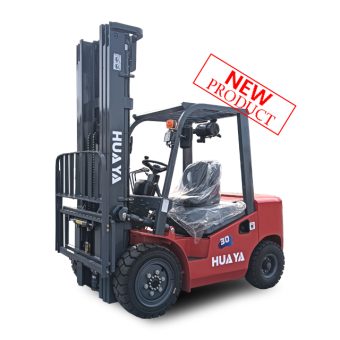
Nachrichten
Gabelstaplerdie oft als die Arbeitspferde in Lagern und Industrieanlagen angesehen werden, gibt es in verschiedenen Formen und Größen. Ein entscheidender Aspekt, der die Fähigkeiten eines Gabelstaplers bestimmt, ist sein Motor. In diesem umfassenden Leitfaden tauchen wir in die komplizierte Welt der Gabelstaplermotoren ein und untersuchen ihre Typen, ihre Leistung und die Faktoren, die die Wahl dieser Kraftpakete beeinflussen.

Im Laufe der Jahre haben sich die Gabelstaplermotoren erheblich weiterentwickelt und spiegeln den technologischen Fortschritt und den Trend zur Nachhaltigkeit wider. Ursprünglich von konventionellen Verbrennungsmotoren angetrieben, haben Gabelstapler die Innovation angenommen und Elektromotoren eingebaut, um die Effizienz zu steigern und die Umweltbelastung zu verringern.
Verbrennungsmotoren (Internal Combustion Engines, ICE) sind die traditionelle Wahl für Gabelstapler. Diese Motoren können mit verschiedenen Kraftstoffen betrieben werden, darunter Benzin, Diesel und Flüssigpropan. Mit Verbrennungsmotoren ausgestattete Gabelstapler sind für ihre Robustheit und ihre Fähigkeit bekannt, schwere Lasten in schwierigen Umgebungen zu bewältigen.
Elektrostapler sind aufgrund ihrer Umweltfreundlichkeit und der niedrigeren Betriebskosten sehr beliebt. Elektrostapler werden von wiederaufladbaren Batterien angetrieben und erzeugen keine Emissionen, was sie ideal für den Einsatz in Gebäuden macht. Sie bieten auch einen leiseren Betrieb und tragen so zu einer angenehmeren Arbeitsumgebung bei.
Wenn es um die Leistung geht, hängt die Wahl zwischen Verbrennungsmotoren und Elektromotoren von den spezifischen Anforderungen des Betriebs ab. Verbrennungsmotorische Gabelstapler eignen sich hervorragend für den Einsatz im Freien, wo Robustheit und hohes Drehmoment entscheidend sind. Andererseits glänzen Elektrostapler in Innenräumen, wo sie einen ruhigeren und leiseren Betrieb bieten.
Bei der Bestimmung des geeigneten Motors für einen Gabelstapler spielen mehrere Faktoren eine entscheidende Rolle. Dazu gehören die Art der Arbeitsumgebung, die Häufigkeit der Nutzung und das gewünschte Maß an Nachhaltigkeit. Unternehmen müssen diese Faktoren sorgfältig abwägen, um eine fundierte Entscheidung treffen zu können, die mit ihren betrieblichen Anforderungen übereinstimmt.
Um die Langlebigkeit und Effizienz eines Gabelstaplermotors zu gewährleisten, ist eine proaktive Wartung erforderlich. Regelmäßige Überprüfungen, rechtzeitige Ölwechsel bei Verbrennungsmotoren und die richtige Pflege der Batterie bei Elektrostaplern sind unerlässlich. Ein gut gewarteter Motor steigert nicht nur die Leistung, sondern minimiert auch Ausfallzeiten und Reparaturkosten.
In einer Zeit, in der das Umweltbewusstsein an erster Stelle steht, hat die Wahl eines Gabelstaplermotors erhebliche Auswirkungen. Da Elektrostapler emissionsfrei sind, tragen sie zu einem umweltfreundlicheren Arbeitsumfeld bei. Unternehmen entscheiden sich zunehmend für elektrische Modelle, um ihre Nachhaltigkeitsziele zu erreichen und ihren CO2-Fußabdruck zu verringern.
A1: Anfangs mögen Elektrostapler höhere Anschaffungskosten haben, aber ihre niedrigeren Betriebskosten und ihre längere Lebensdauer machen sie auf lange Sicht oft kostengünstiger.
A2: Ja, moderne Elektrostapler sind für schwere Lasten ausgelegt, und die Fortschritte in der Batterietechnologie haben ihre Hubkapazität deutlich erhöht.
A3: Elektrostapler benötigen zwar eine Ladeinfrastruktur, diese ist aber nicht unbedingt speziell. Viele Unternehmen können bestehende elektrische Systeme so anpassen, dass sie das Laden von Elektrostaplern ermöglichen.

